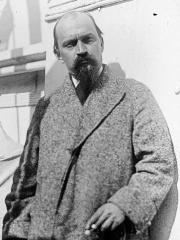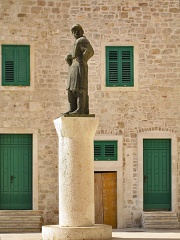


The Most Famous
SCULPTORS from Croatia
Top 3
The following people are considered by Pantheon to be the most legendary Croatian Sculptors of all time. This list of famous Croatian Sculptors is sorted by HPI (Historical Popularity Index), a metric that aggregates information on a biography's online popularity.

1. Ivan Meštrović (1883 - 1962)
With an HPI of 67.14, Ivan Meštrović is the most famous Croatian Sculptor. His biography has been translated into 31 different languages on wikipedia.
Ivan Meštrović (Croatian: [ǐʋan mɛ̂ʃtrɔʋit͡ɕ] ; 15 August 1883 – 16 January 1962) was a Croatian and Yugoslav sculptor, architect, and writer. He was the most prominent modern Croatian sculptor and a leading artistic personality in contemporary Zagreb. He studied at Pavao Bilinić's Stone Workshop in Split and at the Academy of Fine Arts Vienna, where he was formed under the influence of the Secession. He traveled throughout Europe and studied the works of ancient and Renaissance masters, especially Michelangelo, and French sculptors Auguste Rodin, Antoine Bourdelle and Aristide Maillol. He was the initiator of the national-romantic group Medulić (he advocated the creation of art of national features inspired by the heroic folk songs). During the First World War, he lived in emigration. After the war, he returned to Croatia and began a long and fruitful period of sculpture and pedagogical work. In 1942 he emigrated to Italy, in 1943 to Switzerland and in 1947 to the United States. He was a professor of sculpture at the Syracuse University and from 1955 at the University of Notre Dame in South Bend, Indiana. Most of his early works of symbolic themes were formed in the spirit of the Secession, some of which, like the Well of Life, show impressionist restless surfaces created under the influence of Rodin's naturalism, and the second, reviving national myth, become stylized monumental plastics (Kosovo cycle, 1908-1910). Before the First World War, he left pathetic epic stylization, expressing increasingly emotional states, as evidenced by the wooden reliefs of biblical themes made in a combination of Archaic, Gothic, Secessionist and Expressionist styles. During the 1920s and 1930s, the classical component prevailed in his works. In this period, he created a number of public monuments of strong plastic expression, pronounced and legible shapes (Gregory of Nin and Marko Marulić in Split, Andrija Medulić, Andrija Kačić-Miošić and Josip Juraj Strossmayer in Zagreb, Pobednik in Belgrade, Svetozar Miletić in Novi Sad and The Bowman and The Spearman in Chicago). Portraits take a special place in his opus. Meštrović achieved works of strong plastic value in the construction-sculptural monuments and projects, mostly with central layout (the Mausoleum of the Račić family in Cavtat, the Mausoleum of the Meštrović family in Otavice, the Meštrović Pavilion in Zagreb, Monument to the Unknown Hero in Belgrade). He also designed a memorial church of King Zvonimir in Biskupija near Knin inspired by old Croatian churches, a representative family palace, today the Ivan Meštrović Gallery, and reconstructed renaissance fortified mansion Crikvine-Kaštilac in Split.

2. Francesco Laurana (1430 - 1502)
With an HPI of 64.26, Francesco Laurana is the 2nd most famous Croatian Sculptor. His biography has been translated into 23 different languages.
Francesco Laurana, also known as Francesco de la Vrana (Croatian: Frane Vranjanin; c. 1430 – before 12 March 1502) was a Dalmatian sculptor and medallist. He is considered both a Croatian and an Italian sculptor. Though born in the territory of the Republic of Venice, he spent his mature career at the other end of Italy, moving between Naples and Sicily, and Urbino, and finally in southern France, where he died. He was one of the more significant and complex sculptors of the 15th century – complex because of his activities within varying cultural circles and his exposure to differing influences. His best works evolved in the workshop tradition in collaboration with other artists. His portrait busts reveal a creative individuality that was seen as particularly fascinating in the late 19th century. Though it is impossible to chart his stylistic development, his later work made in France shows some assimilation of northern realism, which is absent from the work executed in Italy.

3. Giorgio da Sebenico (1410 - 1473)
With an HPI of 64.25, Giorgio da Sebenico is the 3rd most famous Croatian Sculptor. His biography has been translated into 19 different languages.
Giorgio da Sebenico (lit. 'George of Sebenico') or Giorgio Orsini or Juraj Dalmatinac (lit. 'George the Dalmatian'; c. 1410 – 10 October 1473) was a Venetian sculptor and architect from Dalmatia, who worked mainly in Sebenico (now Šibenik, Croatia), and in the city of Ancona, then a maritime republic.
People
Pantheon has 3 people classified as Croatian sculptors born between 1410 and 1883. Of these 3, none of them are still alive today. The most famous deceased Croatian sculptors include Ivan Meštrović, Francesco Laurana, and Giorgio da Sebenico.
Deceased Croatian Sculptors
Go to all RankingsIvan Meštrović
1883 - 1962
HPI: 67.14
Francesco Laurana
1430 - 1502
HPI: 64.26
Giorgio da Sebenico
1410 - 1473
HPI: 64.25

